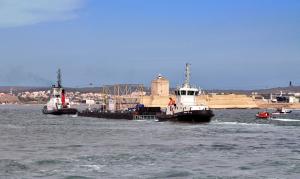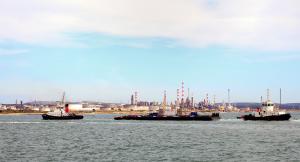Test convoy takes to the sea
Back in September 2013, an 800-ton convoy had tested the physical resistance of the ITER Itinerary—a stretch of 104 kilometres of road between the Mediterranean Sea and the ITER site that has been specially modified for the transport of ITER's most exceptional components (see ITER Mag #1, December 2013)

Seven months later, an identical convoy was underway. This time, the goal was to test the organizational logistics behind the ITER transport operations as well as the maritime portion of the journey from the Mediterranean harbour of Fos to the northeastern shore of the inland sea Étang de Berre—a sort of dress rehearsal in advance of the 250 or so highly exceptional loads that will travel along the ITER Itinerary for six years beginning in late 2014.
For the dozens of participants in the operation, the rendezvous point was a remote wharf at the Fos-sur-Mer industrial harbour. On Saturday 28 March the trailer and its mock load of concrete blocks (800 metric tons in all) were loaded onto a custom barge in an operation that lasted eight hours. Two days later, the barge pushed off from the quay, crossed the Fos harbour and navigated its way along a six-kilometre channel known as the Canal de Caronte that connects the Mediterranean to the Étang de Berre.
Along the banks of the Canal, which crosses the old city centre of Martigues, crowds came out to watch the unusual sight: an 80-metre barge flanked by Coast Guard patrol boats and two tugs, making its slow way along the Canal and finally passing under a draw bridge and into the Étang.
Despite two technical incidents that occurred along the land portion of the Itinerary (related to the trailer's hydraulic system) the test convoy organizers—Agence Iter France, the logistics service provider Daher, and the French authorities—once again proved their mastery of complex technical and logistical issues.
"The incidents we suffered have helped us to identify what could, and should, be improved," stresses Bernard Bon, Daher head of convoy. "This is precisely what tests are for."
The testing phase has now come to an end and the next activity along the ITER Itinerary will be "for real": in October 2014 the first transport convoy will carry an electrical transformer from Korea (87 tons, 8.5 metres long, 4 metres wide and 5 metres high) for the supply of power to the site.



